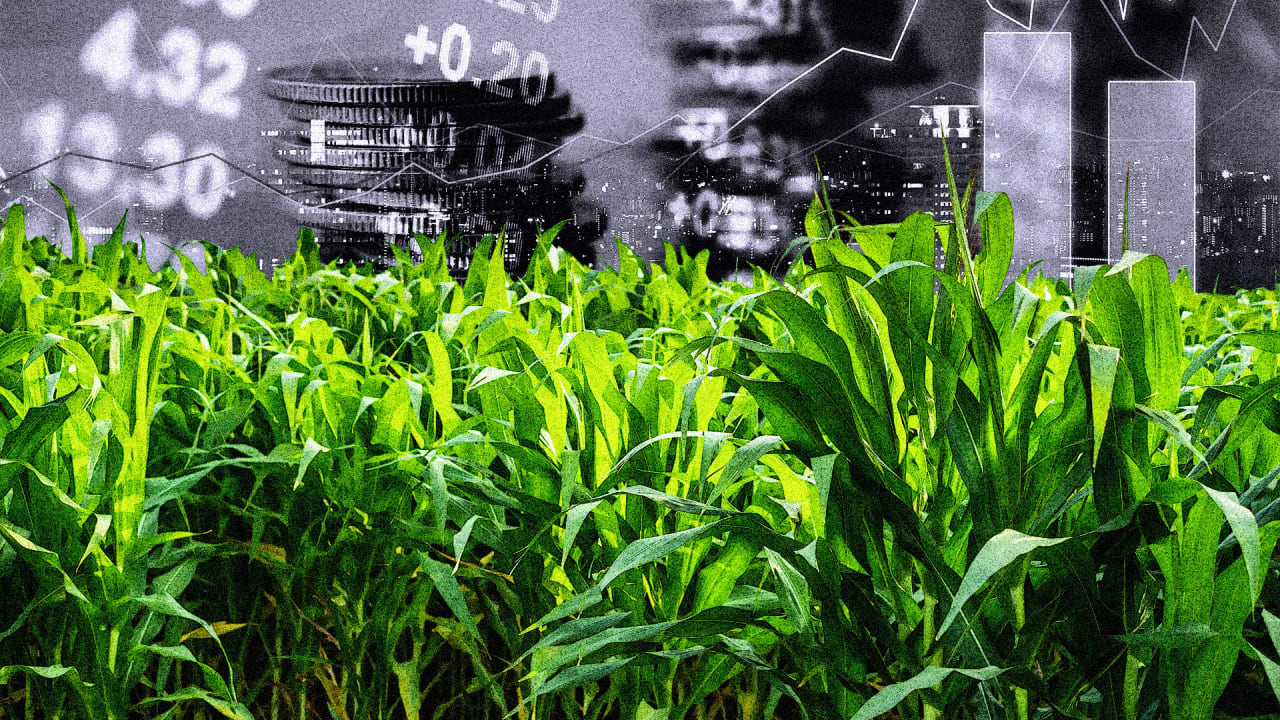How Wall Street can help secure our food supply
Capital is the fuel that enables all industries to stabilize and grow. Yet fresh produce—one of our most important industries ensuring the health and well-being of billions of people around—has traditionally been starved of this fuel. This lack of capital is putting the world’s produce farmers, and a primary source of healthy, nutritious food, at risk when we need them the most. Our future food supply There is consensus among food experts that our future food supply is at risk. Estimates indicate that the global population will reach 10 billion people by 2050, requiring a 60-70% increase in global food production. And it won’t stop there. In a world with shrinking farming acreage and increased demand for sustainably grown, nutritious food, how will we meet this challenge? Imagine a world where our grandchildren struggle to find the fruits and vegetables that were once abundant and that we—their grandparents—had the privilege of easily finding at the supermarket. A world where biting into a juicy slice of watermelon in the summer becomes a luxury and “eat your greens” is no longer a phrase because there are no more greens to eat. I’m convinced they deserve better. And I’m convinced the best way to avoid this dire scenario from happening—while ensuring that sustainable and nutritious food is abundantly accessible, affordable, and profitable—is by investing in those who produce it. The farmer’s plight For a long time, fresh produce growers have experienced limited access to capital, relying solely on financial models that limit their growth and put their operations regularly at risk. For the most part, this has meant traditional bank loans with land as collateral, largely due to the high risks and volatility associated with perishability. Understandably, it’s hard to finance something that may or may not be produced and may or may not maintain its quality along the supply chain journey until it is finally buyer-accepted and paid for. This has not only made life difficult for generations of farmers, it has also led to economic challenges and many farms becoming insolvent, forcing people to move to cities and leaving fewer individuals willing or able to produce enough fruits and vegetables—our major source of nutrients—for a growing global population. More than 140,000 U.S. farms were lost between 2017 and 2022 alone. Additionally, only 9% of today’s total American farms are dedicated to fruits or vegetables, whereas livestock and poultry dominate 38%. Traditionally, banks have been hesitant to accept specialty crops as collateral, considering them to be extremely volatile commodities vulnerable to unpredictable factors such as weather, pests, or their own perishability. And they are indeed volatile. According to the USDA shipping point pricing information, some commodities, such as mangoes, had an estimated annualized pricing volatility of 147% in 2023 alone. However volatile fresh produce commodities may be, this viewpoint has historically restricted financing options for farmers, who nevertheless require working capital each season to pay for inputs, labor, and adoption of new technology. Further exacerbating the issue, it’s not just that banks refuse crops as collateral, but also that farmers frequently lack the guaranteed collateral needed, leaving them with few alternative options. As a consequence, growers have been forced to put at risk their only means to exist: land. Look at specialty crops as a new investable asset class We owe it to our farmers—and to future generations—to create a more stable and less volatile fresh produce industry. Capital is the key to unlocking this stability. Here are three ways that the finance community can leverage capital differently to unlock stability, drive sustainability, and ensure farmer economic health: Learn from other perishable and highly bankable industries. We’ve done it before with other perishable commodities, like energy, which disappears instantly, making it exponentially more perishable than apples. We must evaluate how the energy industry structures deals to ensure that all parties are equally protected and yet still profitable. There’s much to learn here and from other perishable industries. Evolve traditional commercial practices between buyers and sellers to move risk off of growers’ balance sheets. When growers fail, the entire supply chain and food system are at risk. We need to better distribute this risk throughout the supply chain. I believe we can do this and increase the returns for all parties in fresh produce by creating more predictable and long-term commitments between buyers and sellers. Lower the cost of capital. We can do this by leveraging the balance sheets of retailers as off-takers and better aligning crop insurance with other financial products that support growers. With lower capital costs, growers will be able to borrow more and improve their liquidity to manage through inevitable supply

Capital is the fuel that enables all industries to stabilize and grow. Yet fresh produce—one of our most important industries ensuring the health and well-being of billions of people around—has traditionally been starved of this fuel. This lack of capital is putting the world’s produce farmers, and a primary source of healthy, nutritious food, at risk when we need them the most.
Our future food supply
There is consensus among food experts that our future food supply is at risk. Estimates indicate that the global population will reach 10 billion people by 2050, requiring a 60-70% increase in global food production. And it won’t stop there. In a world with shrinking farming acreage and increased demand for sustainably grown, nutritious food, how will we meet this challenge?
Imagine a world where our grandchildren struggle to find the fruits and vegetables that were once abundant and that we—their grandparents—had the privilege of easily finding at the supermarket. A world where biting into a juicy slice of watermelon in the summer becomes a luxury and “eat your greens” is no longer a phrase because there are no more greens to eat.
I’m convinced they deserve better. And I’m convinced the best way to avoid this dire scenario from happening—while ensuring that sustainable and nutritious food is abundantly accessible, affordable, and profitable—is by investing in those who produce it.
The farmer’s plight
For a long time, fresh produce growers have experienced limited access to capital, relying solely on financial models that limit their growth and put their operations regularly at risk. For the most part, this has meant traditional bank loans with land as collateral, largely due to the high risks and volatility associated with perishability. Understandably, it’s hard to finance something that may or may not be produced and may or may not maintain its quality along the supply chain journey until it is finally buyer-accepted and paid for.
This has not only made life difficult for generations of farmers, it has also led to economic challenges and many farms becoming insolvent, forcing people to move to cities and leaving fewer individuals willing or able to produce enough fruits and vegetables—our major source of nutrients—for a growing global population. More than 140,000 U.S. farms were lost between 2017 and 2022 alone. Additionally, only 9% of today’s total American farms are dedicated to fruits or vegetables, whereas livestock and poultry dominate 38%.
Traditionally, banks have been hesitant to accept specialty crops as collateral, considering them to be extremely volatile commodities vulnerable to unpredictable factors such as weather, pests, or their own perishability. And they are indeed volatile. According to the USDA shipping point pricing information, some commodities, such as mangoes, had an estimated annualized pricing volatility of 147% in 2023 alone.
However volatile fresh produce commodities may be, this viewpoint has historically restricted financing options for farmers, who nevertheless require working capital each season to pay for inputs, labor, and adoption of new technology. Further exacerbating the issue, it’s not just that banks refuse crops as collateral, but also that farmers frequently lack the guaranteed collateral needed, leaving them with few alternative options. As a consequence, growers have been forced to put at risk their only means to exist: land.
Look at specialty crops as a new investable asset class
We owe it to our farmers—and to future generations—to create a more stable and less volatile fresh produce industry. Capital is the key to unlocking this stability. Here are three ways that the finance community can leverage capital differently to unlock stability, drive sustainability, and ensure farmer economic health:
- Learn from other perishable and highly bankable industries. We’ve done it before with other perishable commodities, like energy, which disappears instantly, making it exponentially more perishable than apples. We must evaluate how the energy industry structures deals to ensure that all parties are equally protected and yet still profitable. There’s much to learn here and from other perishable industries.
- Evolve traditional commercial practices between buyers and sellers to move risk off of growers’ balance sheets. When growers fail, the entire supply chain and food system are at risk. We need to better distribute this risk throughout the supply chain. I believe we can do this and increase the returns for all parties in fresh produce by creating more predictable and long-term commitments between buyers and sellers.
- Lower the cost of capital. We can do this by leveraging the balance sheets of retailers as off-takers and better aligning crop insurance with other financial products that support growers. With lower capital costs, growers will be able to borrow more and improve their liquidity to manage through inevitable supply chain challenges.
We must evolve our financing models to start looking at specialty crops as an asset class, not a risk class. By doing so, we can unlock liquidity and growth for growers while also delivering sustainable, nutritious food to consumers at stable prices. By not worrying about how to survive, farmers will be able to invest in technologies that increase productivity, reduce waste, and improve sustainability. With these investments we are securing their livelihoods and the food security of billions. In a world facing a future of food scarcity, securing the existence of our food supply, and therefore of economically viable farms, is an urgent imperative. The time to act is now.
Patrick McCullough is CEO of ProducePay.






















